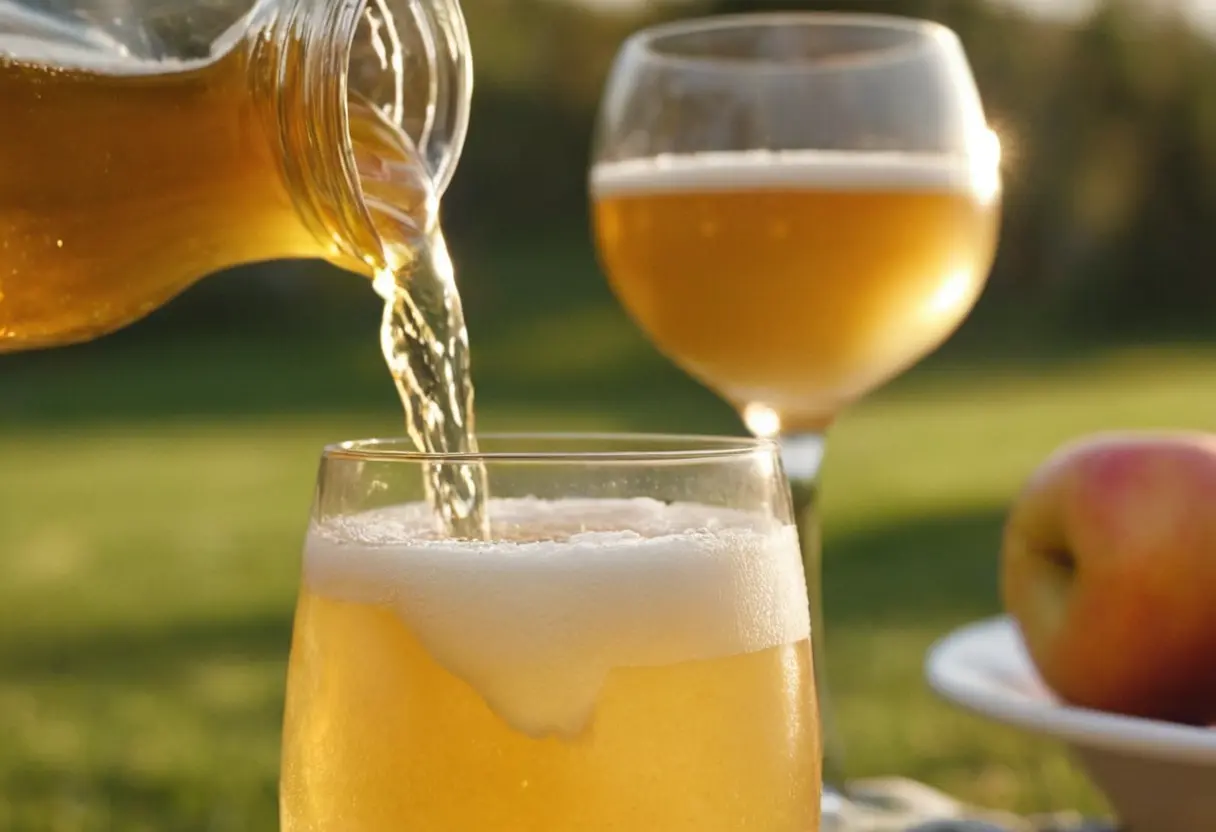Looking for the perfect hard apple cider recipe? Tired of the same old store-bought options, wishing you could customize the flavor of your hard cider?
Forget those generic ciders! Imagine crafting your own unique hard cider at home – controlling the sweetness, the flavor, and the bubbly kick.
Dive into our Ultimate Guide to Making hard apple cider recipe at Home. We’ll walk you through everything – from selecting the perfect apples to bottling your own delicious creation. Get ready to discover the joy of DIY hard cider and impress your friends with your homemade brewing skills!
Hard Cider Making at a Glance
- Gather supplies and ingredients
- Select and juice apples
- Sanitize everything
- Prepare juice
- Pitch yeast and ferment
- Bottle, carbonate, and enjoy!
Table of contents
Introduction & Essentials
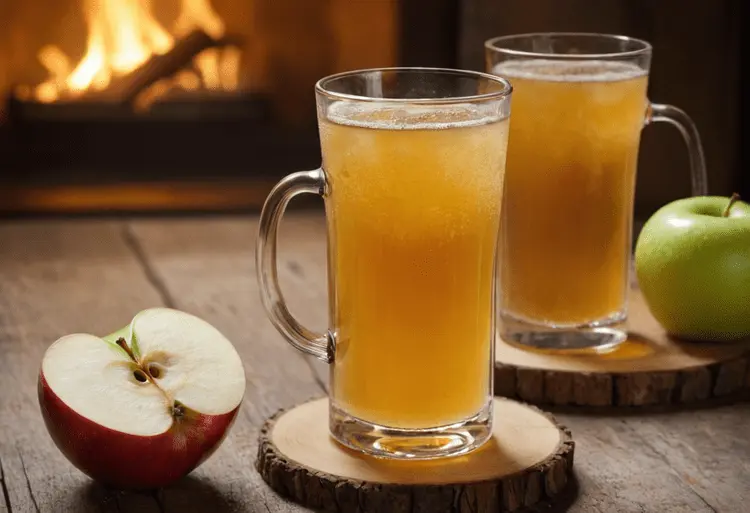
The Ultimate Guide to Crafting Your Own Delicious Hard Apple Cider
Have you ever dreamed of making your own hard apple cider recipe? That crisp, refreshing drink with a perfect balance of sweetness and a subtle alcoholic kick? Well, guess what – you absolutely can!
Making hard apple cider recipe at home is surprisingly simple and incredibly rewarding.
Let me share a secret. One of my fondest childhood memories is the smell of fresh apples mingling with the warm spices of my grandmother’s homemade hard cider. This recipe evokes a sense of tradition, and I’m excited to guide you through the journey!
Discover the Joy of Homemade Hard Apple Cider Recipe
What makes home-brewed hard apple cider recipe so special?
- Customization: You’re the cider master! Control sweetness, flavors, and alcohol content.
- Satisfaction: There’s immense pride in crafting (and drinking!) something you made yourself.
- Simplicity: Don’t be intimidated – the process is surprisingly straightforward.
Essential Equipment
Before we dive in, let’s gather your cider-making toolkit:
- Large Pot: For warming juice and dissolving sugar.
- Fermenting Vessel: Glass carboy or food-grade bucket are ideal.
- Airlock & Stopper: Allows gasses to escape while keeping air out.
- Hydrometer (Optional): Measures sugar content and helps track fermentation.
- Sanitizer: Crucial for preventing spoilage – check out these guidelines for safe apple cider making
- Siphoning Equipment: For transferring your cider.
- Bottles or Growlers: To store your finished masterpiece.
Key Ingredients
Now, let’s talk about the heart of your cider:
- Apple Juice/Cider: Fresh-pressed is best, but store-bought works too; avoid preservatives.
- Yeast: Champagne yeast is reliable; wild fermentation is for the more adventurous.
- Sugar (Optional): Brown, white, or honey for extra sweetness or higher alcohol content.
- Flavorings (Optional): Spices, fruits, get creative!
Choosing The Perfect Apples + Making the Juice
The Secret Starts with the Apples
Think of apples as the soul of your hard cider. Want a sweet cider? How about a tart and tangy one? Or, maybe a perfectly balanced flavor explosion? The apples you choose will make all the difference!
Let’s talk apple varieties. A mix of sweet, tart, and tannic apples creates the most delicious hard cider. Here’s a quick guide:
- Sweet: Golden Delicious, Gala, Fuji
- Tart: Granny Smith, Honeycrisp
- Tannic: Traditional cider apples (often harder to find, like Dabinett or Kingston Black)
Farmer’s markets and local orchards are treasure troves for amazing cider apples. Ask the farmers for recommendations – they’re the experts!
Juicing Options
Now, how do we get that delicious juice? There are a couple of ways:
- Buying Fresh-Pressed: The easiest route! Look for quality cider that’s free of preservatives. For the ultimate in freshness.
- Juicing Your Own: Got the equipment and a little extra time? Juicing your own apples lets you create custom blends – the possibilities are endless!
My Hard Apple Cider Recipe Secret? A Family Tradition
I remember helping my grandpa make hard cider from the apples in his orchard. The aroma of fresh-pressed juice is one of my favorite childhood memories. That’s why making hard cider always feels a little bit like magic to me.
Time to Get Juicy!
Whether you buy fresh-pressed or make your own, crafting delicious hard cider from scratch is an incredibly rewarding experience.
Let me know in the comments below – what’s your favorite apple combo for hard cider? And don’t forget to share those cider pics on social media – tag me so I can see your creations!
Check out more mouth watering recipes:
Apple Crisp Recipe Without Oats: Perfect Classic Reinvented
Apple Canning Recipes + Step-by-Step Guide
Apple Blossom Dessert: Your New Fall Favorite | Recipes & Tips
The Fermentation Process: The Magic of Transformation
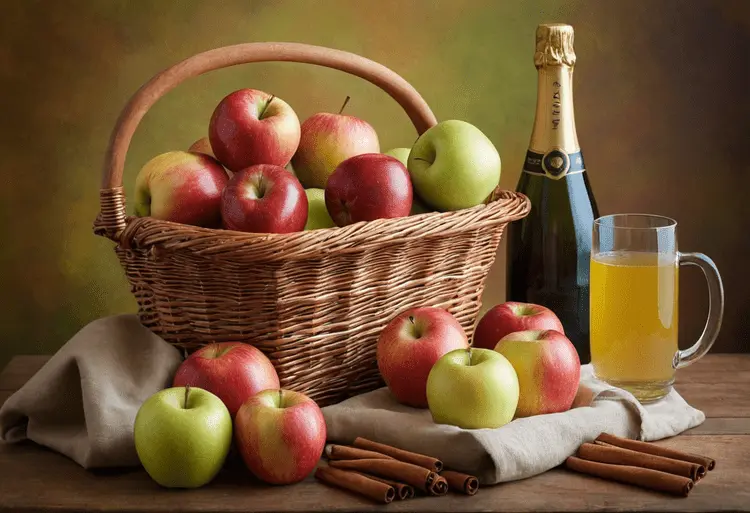
Let the Yeast Work Its Magic: Mastering Fermentation
Picture this: your sweet apple juice bubbling with excitement, the airlock gurgling with rhythmic pops. Something magical is happening – your juice is becoming hard cider! Are you ready to learn the secrets of fermentation?
Sanitization: Your First Line of Defense
Cleanliness is key, my friends! Before we start anything, we need to sanitize everything that will touch our precious cider. Think of it as protecting your cider from unwanted intruders (a.k.a bacteria).
A good sanitizing solution will make sure only the good yeast gets to have all the fun.
Preparing the Hard Apple Cider Recipe Must: Sweet Beginnings
Think of your ‘must’ as the base camp for your happy yeast. This is where you can get creative! Is your cider going to be on the sweeter side? Add some extra sugar to the mix. Want it bone dry?
Let the natural sweetness of the apples shine. Some folks like adding a bit of yeast nutrient, giving the yeast a boost for a healthy fermentation.
Pitching the Yeast: The Party Starts Now!
Here’s where the real magic begins. Dry yeast needs a little wake-up call – rehydration in some warm water gets them active. But remember those wild yeasts that naturally live on apple skins?
If you’re feeling adventurous, you can skip the added yeast and let nature do its thing! This method has a hint of unpredictability, which some cider-makers absolutely love.
Primary Fermentation: The Bubbly Phase
Now, seal your cider away with an airlock. This lets the good stuff (carbon dioxide) escape while keeping the bad stuff (oxygen and nasties) out.
Watch for those bubbles! It means your yeast is feasting on the sugars, turning them into alcohol and delicious cider-y flavors.
This is also a great time to get familiar with your hydrometer, a nifty tool for tracking how much sugar is left (and figuring out how strong your cider will be).
Racking to Secondary: Time for a Change
Once the initial frenzy of fermentation dies down, it’s time to ‘rack’ your cider. This means gently transferring it to a new, clean vessel, leaving any sediment behind. It’ll make your hard cider clearer and taste even better.
Flavor Additions (Optional): Your Creative Touch
Feeling creative? This is where you get to play! Spices like cinnamon and ginger add lovely warmth. A handful of tart berries can turn your cider a beautiful pink. Remember, timing is important here. Adding these goodies during fermentation lets the flavors really infuse.
Patience Pays Off: Bottling, Aging, and the Perfect Taste
Ready to see those bubbles come to life? Bottling and conditioning are where the real magic happens in your hard apple cider recipe journey. Let’s dive in!
Sparkles and Shine: Cleaning and Sanitizing
First things first, cleanliness is king! Give those bottles or growlers (or your keg, if that’s your style) a thorough scrub and soak with a food-grade sanitizer. We don’t want any pesky bacteria spoiling the party, do we?
Hard Apple Cider Recipe Sweetness Factor: Priming for Carbonation
If you crave a bubbly cider, priming time is here! A tiny bit of sugar dissolved in water is all you need to give those dormant yeast a final energy boost. They’ll wake up and create that delightful carbonation within your bottles.
The Waiting Game: Carbonation and Conditioning
Now, it’s time to stash your filled bottles in a cool, dark place. Patience is your friend here! It’ll take a couple of weeks for those bubbles to develop.
Is the anticipation building? I remember when I first made hard apple cider – I’d sneak peeks at the bottles, hoping for signs of life!
Hard Apple Cider Recipe Flavor Deepens: Aging (Optional)
While aging isn’t strictly necessary, it can take your hard apple cider recipe to the next level. If you’ve got the willpower, let some bottles rest for a few months. You’ll be rewarded with mellower, more complex flavors.
Bonus Tip: Keep a notebook to track different bottling dates and any flavor additions. You’ll discover what you love best and can refine your recipe over time.
Hard Apple Cider Recipe Troubleshooting & Advanced Techniques
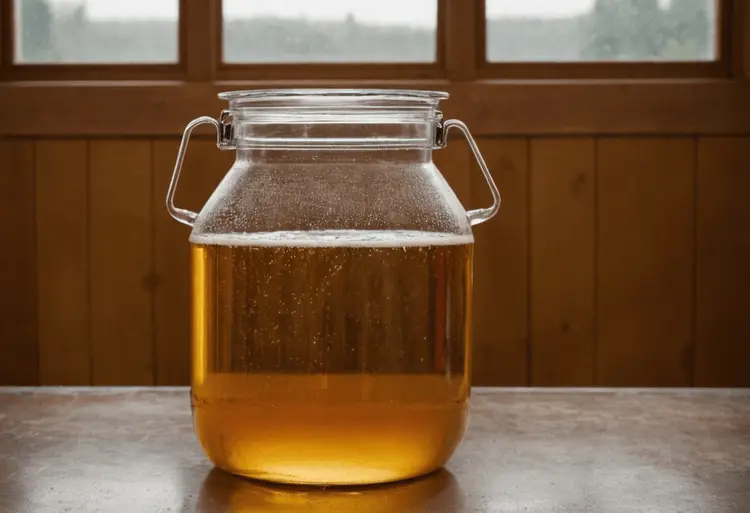
Hard Apple Cider Recipe Hiccups? Master the Fix and Level Up Your Brew
Sometimes, even the best-laid plans go a little wonky in the world of fermentation. Don’t panic! Let’s troubleshoot common hard cider problems and take your brewing skills to the next level.
Hard Apple Cider Recipe Common Problems
- My cider won’t ferment! Is your yeast happy? Check the temperature (too hot or cold can stall things) and ensure your sanitizer didn’t accidentally take out your yeast along with any unwanted microbes. A little yeast nutrient can sometimes give things a kickstart.
- Something smells funky. Off-flavors can be a bummer. A vinegary smell might mean bacteria got the party started instead of your yeast. Sadly, there’s often not much to do but learn from it and sanitize meticulously next time.
- Where are the bubbles? If your cider lacks that delightful fizz, you might have a leak in your airlock or bottle caps. Double-check your seals. If everything’s tight, give it a little more time – carbonation can be sneaky.
Hard Apple Cider Recipe Advanced Techniques
Ready to get fancy? Here’s where things get really fun with your hard cider:
- Take control of the sweetness. Hydrometers (you can find them at your favorite brewing supply store, let you measure sugar levels. This helps you tailor your hard cider to be perfectly dry, slightly sweet, or anywhere in between.
- Balance the flavors. A touch of acid can brighten up a flabby cider. Experiment with food-grade malic or tartaric acid – a little goes a long way!
- Hop heads unite! Dry hopping your cider adds a burst of aroma, just like in your favorite IPAs. Experiment with different hop varieties for a unique twist.
Chef’s Tip: I remember the first time I tried making hard cider – it was a family project with apples from our old orchard. We ended up with something more like apple cider vinegar… but hey, that made a fantastic salad dressing! Don’t be afraid of those ‘failures’ – they’re the best teachers.
Let me know what challenges you’ve faced with your hard cider, or what techniques you’re excited to try next! Share your creations on social media and tag me – I’d love to see what you brew up!
Got Hard Apple Cider Recipe Questions? We’ve Got Answers!
Apple juice is fermented with yeast, which turns the sugar into alcohol. It’s a similar process to making wine!
Hard cider is typically made with wine or champagne yeast, resulting in an alcohol content between 4-8%.
The essential ingredients are apple juice and yeast. You can also add sugar for sweetness or other flavorings like spices or fruit.
Yes! Just avoid juices with preservatives. Opt for pasteurized juice for the best results.
Blending is your friend! Mix a sweeter or drier cider to adjust the sweetness level to your liking.
Primary fermentation usually takes 1-3 weeks. Keep an eye on your airlock – no more bubbles means fermentation might be complete.
If it smells or tastes off (like vinegar or mold), it’s best to discard it. Prioritize sanitation during the entire process to keep your cider safe.
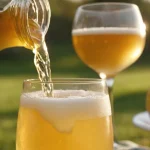
Hard Apple Cider Recipe: The Ultimate Guide
- Total Time: 30 minutes
Description
Learn how to create your own delicious hard apple cider at home with this comprehensive guide. From selecting the perfect apples to mastering fermentation and bottling, discover the joy of crafting your own custom cider.
Ingredients
- Apple Juice/Cider (fresh-pressed or quality store-bought, free of preservatives)
- Yeast (Champagne yeast for reliability, or consider wild fermentation)
- Sugar (optional, for sweetness or higher alcohol content)
- Flavorings (optional, such as spices or fruits)
Instructions
-
Gather Supplies and Ingredients:
- Get a large pot, fermenting vessel (like a glass carboy), airlock & stopper, sanitizer, hydrometer (optional), siphoning equipment, and bottles or growlers.
-
Select and Juice Apples:
- Choose a mix of sweet, tart, and tannic apples.
- Either buy fresh-pressed cider or juice your own apples for a custom blend.
-
Sanitize Everything:
- Clean and sanitize all equipment thoroughly to prevent contamination.
-
Prepare Juice:
- Warm the apple juice in a pot and dissolve sugar if adding any.
- Cool the juice to the proper temperature for yeast pitching.
-
Pitch Yeast and Ferment:
- Rehydrate yeast in warm water according to package instructions.
- Add yeast to the cooled juice in the fermenting vessel.
- Seal with an airlock and ferment until bubbles stop, indicating primary fermentation is complete.
-
Bottle, Carbonate, and Enjoy:
- Sanitize bottles or growlers thoroughly.
- Optionally, prime with a sugar solution for carbonation.
- Store in a cool, dark place for a few weeks to allow carbonation and maturation.
Notes
- Experiment with different apple varieties and flavorings to customize your cider.
- Monitor fermentation using a hydrometer to track sugar levels and alcohol content.
- Proper sanitation is crucial at every step to prevent spoilage.
- Prep Time: 30 minutes
Keywords: Hard cider recipe, homemade cider, apple cider fermentation, cider making, DIY cider, craft cider.

